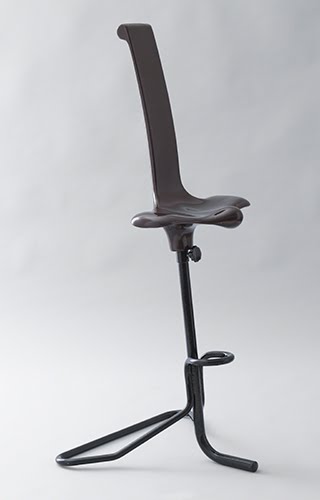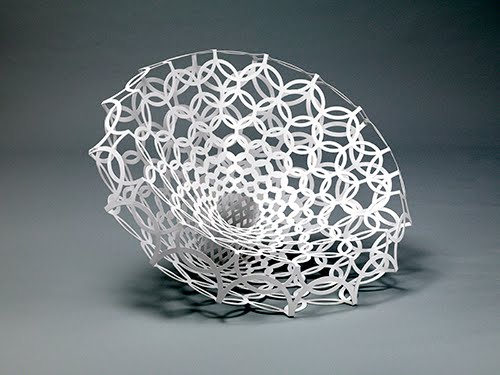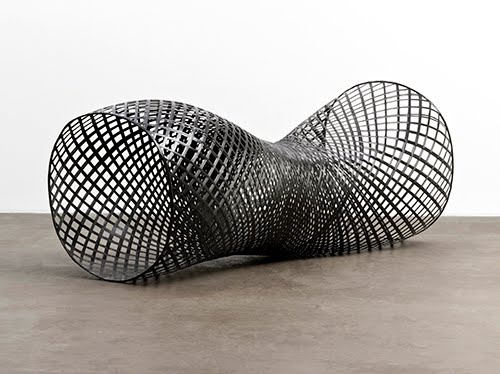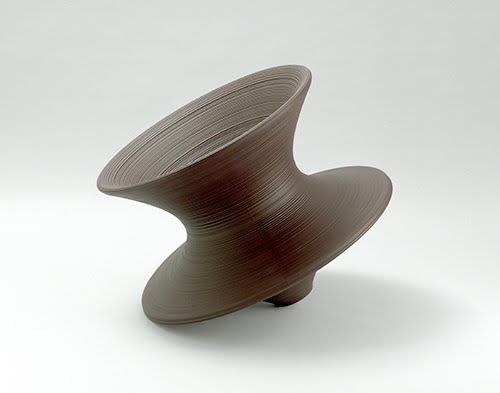Furniture or Sculpture?
I took furniture history classes in grad school and even was a TA for the professor, so I learned to absolutely love studying the history of furniture. It seems to me, though, as our digital image collection of contemporary furniture design grows, the question marks pile up in my head. Has furniture design gone so far that it has transcended the traditional criteria that it be designed to conform to the human body?
I know that furniture design fell under the spell of combining “fine arts aesthetics” with industrial design starting with the Arts and Crafts movement in the late 1800s, and then the Bauhaus in the early 1900s. At first glance, it would seem that many designers have gone way beyond this battle cry in designing furniture that seems more like an aesthetic emphasis (i.e. sculpture) than something convenient on which to sit. And yet, there are stories behind a lot of these designs. You decide.
 |
| Claudio Slocchi (designer, 1934–2012, Italy) and Sangiacomo (manufacturer, 1968 to present, Milan), Appoggio Chair, 1971. Fiberglass and steel, 46 ½" x 22" x 20" (118.1 x 55.9 x 50.8 cm). The Museum of Modern Art, New York. © 2018 Claudio Slocchi. (MOMA-D1059) |
Claudio Slocchi (1934–2012) was an architect and an industrial and interior designer. He studied at Milan Polytechnic and taught interior and furniture design at the University of Rome. He was also involved with the State Institute of Furnishings in Lissone. Apparently one of Slocchi’s aesthetics was minimalism, because this sit/stand stool sums that up.
The Appoggio Chair was designed by Slocchi to conform to tight spaces where regular sitting was not possible. I guess this would work in offices nowadays where we are encouraged to stand at our desks most of the day as “healthier.” Slocchi based his design to cradle the pelvis, basing the seat design on a bicycle seat. The chair is also adjustable vertically. That means that it adjusts for differences in human height, thus accommodating the human body. I wouldn’t be surprised if these chairs make a comeback!
Speaking of minimalism, check out another one of his chair designs.
 |
| Louise Campbell (designer, born 1970, Denmark) and Zanotta S.p.A. (manufacturer, 1954 to present, Milan, Italy), Veryround Chair, 2006. Laser-cut sheet steel, 27 3/16" x 41 ½" x 32 11/16" (69 x 105.5 x 83 cm). The Museum of Modern Art, New York. © 2018 Louise Campbell. (MOMA-S1335) |
Denmark has been a leader in contemporary furniture design since the middle of the 1900s. Louise Campbell (born 1970) graduated from the London College of Furniture in 1992 and studied further at the Industrial Design Department of the Danish Design School (1993–1995) in Copenhagen. Her emphasis is on furniture, lighting, and interior design.
This chair is a puzzle to me, because I can’t imagine it is either easy to sit down in or easy to get out of. Campbell’s designs are experimental, and she has stated that she is happy her chairs don’t look like chairs. Her designs are based on the aesthetic of repeating circles (240 in this chair) and an interest in positive and negative space. Interesting about this design is that it is precision cut from sheet steel. Theoretically, the layers blend together to be solid, at the same time giving it the appearance of paper.
 |
| Mathias Bengtsson (born 1971, Denmark), Spun Chais Lounge, 2003. Carbon fiber, 34 ¼" x 33 7/16" x 82 11/16" (87 x 85 x 210 cm). The Museum of Modern Art, New York. © 2018 Mathias Bengtsson. (MOMA-D0905) |
Everything I’ve read about this piece indicates that the artist, Mathias Bengtsson (born 1971), wants it considered not only furniture, but also fine art. His website indicates that the artist feels issues of comfort and convenience in furniture design were established long ago, including the study of ergonomics in the 1960s. He wants his furniture to “challenge the senses.” He also challenges himself with the materials he chooses—such as spun carbon fiber—to accomplish in his designs. He prefers to think of his furniture designs as domestic objects made artistically, rather than a work of art made comfortable. The chair is machine-woven from a computer program using lightweight but strong carbon fiber, a clothing material.
Bengtsson, born in Copenhagen, studied furniture design at the Danish College of Design, the Art Center College in Lausanne, Switzerland, and the Royal College of Art in London. The Spun Chaise Lounge is just one of his innovative uses of materials. He also makes chairs out of stacks of used paper glued together.
 |
| Thomas Heatherwick (designer, born 1970, Britain) and Magis S.p.A. (manufacturer, 1976 to Presenty, Treviso, Italy) Spun Seat, 2009. Polyethylene, 26" x 36" (66 x 91.4 cm). The Museum of Modern Art, New York. © 2018 Thomas Heatherwick (MOMA-S1378) |
The Hive commercial website of home design products advertises the Spun Chair as something good for people who don’t like sitting still all day, but rather spin and roll. It came out of research into the redefinition of the common elements of chair design (such as front and back) and its simplification into basic geometric shapes. And forget about such standard terms as “leg,” “arm,” or “stretcher.” These are not needed! The designer, Thomas Heatherwick (born 1970), is also interested in the use of nontraditional materials in his designs.
Heatherwick, born in London, was educated in three-dimensional design at Manchester Polytechnic (1988–1991) and the Royal College of Art (1992–1994). He established his own firm, Heatherwick Studio, in 1994, but has designed furniture for many firms, including Herman Miller in the US. His firm is primarily focused on architecture and public art that not only emphasizes unusual use of conventional materials, but the exploration of green technology and design. Some of his architectural plans, such as the Pier 55 on the Hudson River, New York (ongoing), are amazing in the way they incorporate green into the urban environment.
Correlations to Davis programs: Explorations in Art Grade 1: 6.35; Explorations in Art 2E Grade 1: 6.7; Explorations in Art Grade 2: 6.35-36; Explorations in Art 2E Grade 2: 6.9; Discovering Art History 4E: 2.2


Comments